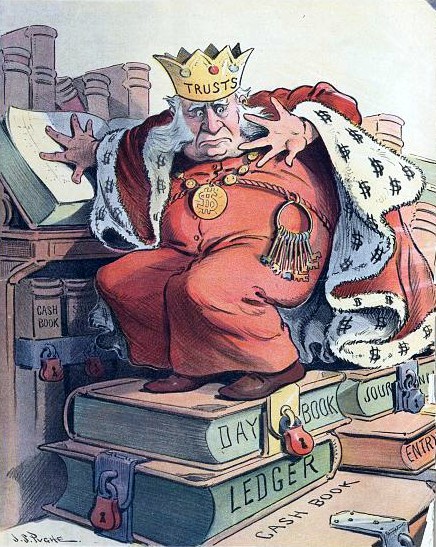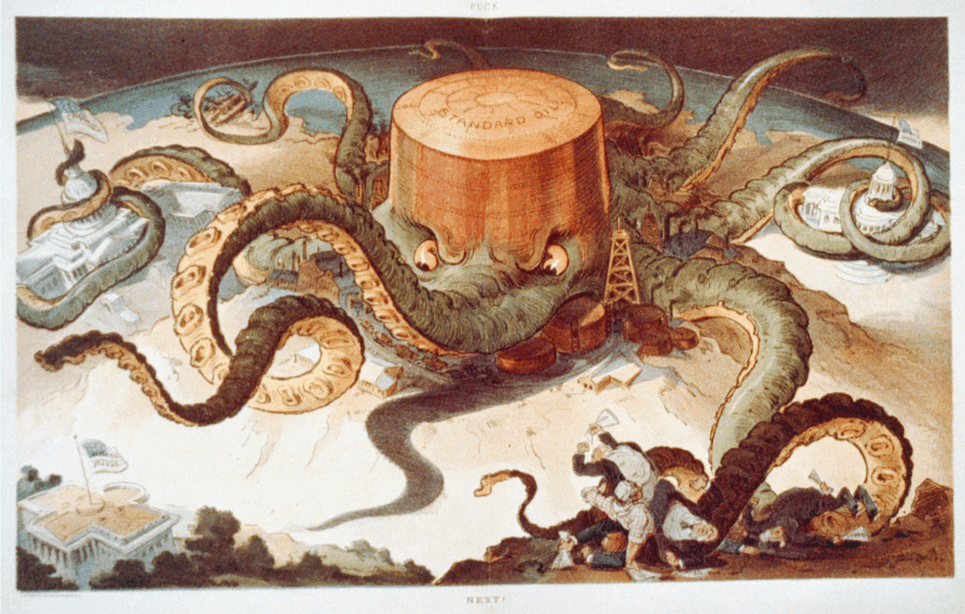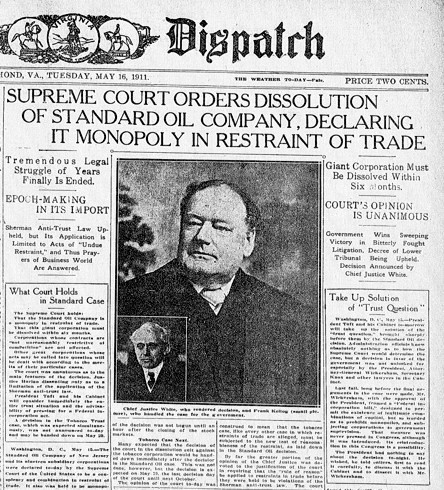|
Big
business - O.K.
Monopoly - NOT! John D. Rockefeller was a business genius. Even his critics admitted that. After the Standard Oil Company was started in 1870, it grew rapidly and became one of the most successful businesses in the country. Before long, however, there were complaints that Standard Oil was taking over practically the entire oil refining business. This same pattern was also being noticed in some other industries. One company would get so large it controlled all or almost all of that industry. A company that controls the market for its product is called a monopoly. In those days, monopolies were also called trusts. |
A monopoly is when one company controls all or almost all of the supply of a product. As a result, there is little or no competition in that industry from other companies. When there is no competition, the monopoly can raise prices higher than they would be otherwise. |
The political cartoon below is from an 1881 issue of Puck, a popular magazine of that time.
It shows there was growing concern by the public about the problem of monopolies.
The magazine's symbol, the little boy with the top hat, is asking Uncle Sam
(representing the U.S. government), "What are you going to do about it?"

 |
"We need a law against monopolies! We need to stop the trusts!" There was so much concern about the growing problem of monopolies that newspapers, consumers, and even many business leaders demanded that something to be done. In 1890, Congress responded by passing the Sherman Anti-Trust Act. Here is a summary of what the law said: Any attempt to form a monopoly or
trust that restricts trade is illegal.
As this political cartoon
from 1902 shows, however, the
new law did not make the problem go away. The monopolies
simply found ways to get around the law. |
|
Ida Tarbell exposed the Standard Oil Company Starting in 1902, a magazine reporter named Ida Tarbell began exposing the ways the Standard Oil Company got almost total control of the oil industry. Tarbell detailed how the company bought out other oil refiners, or deliberately made it difficult for them to stay in business. She explained how secret deals with the big railroad companies gave the Standard Oil Company an advantage over the other oil companies. Rockefeller, she reported, even had spies working in other oil businesses. Ida Tarbell agreed that Rockefeller had created an amazingly productive business. By showing the unfair methods that were sometimes involved, however, she highlighted the need for real action. |
 |
The famous political cartoon below is from the pages of Puck magazine in 1904. The
cartoon shows the Standard Oil company as a giant octopus wrapping it tentacles around
the steel and shipping industries, as well as the U.S. Capitol building, a state capitol
building, and even reaching toward the White House.

|
The end of the Standard Oil Company monopoly In 1911, at the end of a long court case, the U.S. Supreme Court ruled that the Standard Oil Company was operating in violation of the law against monopolies. The court ordered the oil company to break itself up into smaller companies, so that no one company would dominate or control the industry. The decison put all big businesses on notice that if they became monopolies and restricted competition unfairly, they would land in court. Click here to see the full front page of the newspaper. |
 |
The photos and images are from the Library of Congress.
Some images have been edited or resized for this page.
|
Copyright Notice
Copyright 2009, 2020 by David Burns. All rights reserved. |